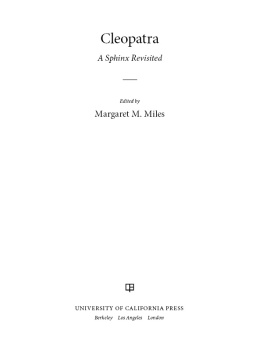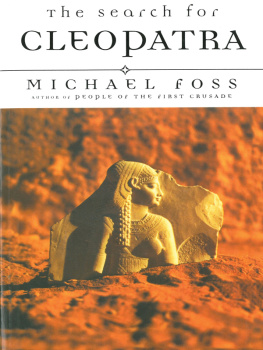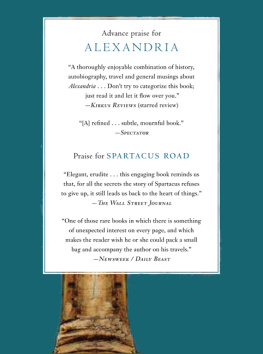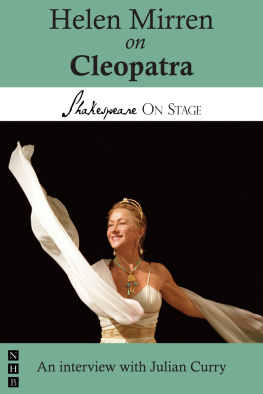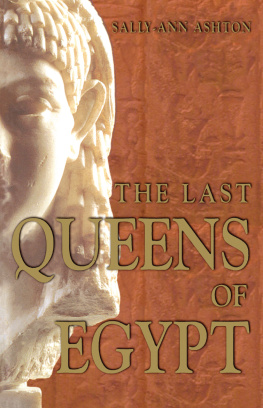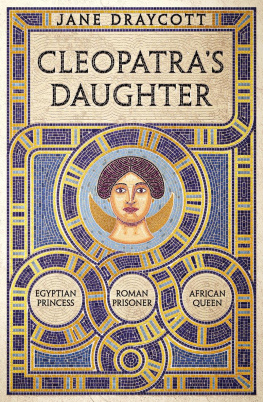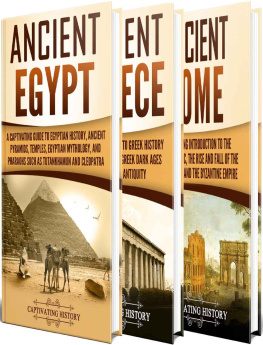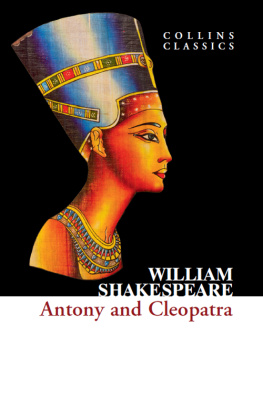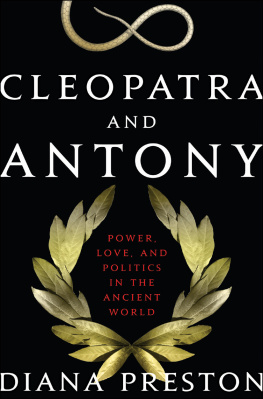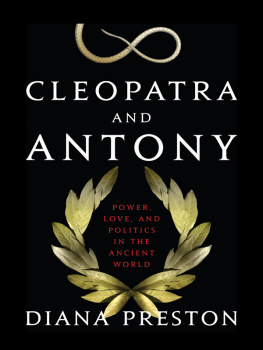Cleopatra
Cleopatra
A Sphinx Revisited
______
Edited by
Margaret M. Miles

UNIVERSITY OF CALIFORNIA PRESS
Berkeley Los Angeles London
University of California Press, one of the most distinguished university presses in the United States, enriches lives around the world by advancing scholarship in the humanities, social sciences, and natural sciences. Its activities are supported by the UC Press Foundation and by philanthropic contributions from individuals and institutions. For more information, visit www.ucpress.edu.
University of California Press
Berkeley and Los Angeles, California
University of California Press, Ltd.
London, England
2011 by The Regents of the University of California
Library of Congress Cataloging-in-Publication Data
Cleopatra : a sphinx revisited / edited by Margaret M. Miles.
p. cm.
Includes bibliographical references and index.
ISBN 978-0-520-24367-5
1. Cleopatra, Queen of Egypt, d. 30 B.C. 2. EgyptHistory33230 B.C. 3. RomeHistoryRepublic, 26530 B.C. 4. QueensEgyptBiography. 5. EgyptKings and rulersBiography. I. Miles, Margaret Melanie.
DT92.7.C54 2011
932'.021092dc22
[B]
2011012446
Manufactured in the United States of America
20 19 18 17 16 15 14 13 12 11
10 9 8 7 6 5 4 3 2 1
In keeping with a commitment to support environmentally responsible and sustainable printing practices, UC Press has printed this book on 50-pound Enterprise, a 30% post-consumer-waste, recycled, deinked fiber that is processed chlorine-free. It is acid-free and meets all ANSI/NISO (Z 39.48) requirements.
The Joan Palevsky Imprint in Classical Literature

In honor of beloved Virgil
O degli altri poeti onore e lume
Dante, Inferno
CONTENTS
Margaret M. Miles
UNIVERSITY OF CALIFORNIA, IRVINE
Sally-Ann Ashton
FITZWILLIAM MUSEUM, CAMBRIDGE
Erich S. Gruen
UNIVERSITY OF CALIFORNIA, BERKELEY
Robert A. Gurval
UNIVERSITY OF CALIFORNIA, LOS ANGELES
Sarolta A. Takcs
SAGE COLLEGE, ALBANY
Brian A. Curran
PENNSYLVANIA STATE UNIVERSITY
Ingrid D. Rowland
UNIVERSITY OF NOTRE DAME, ROME
Margaret Mary DeMaria Smith
UNIVERSITY OF CALIFORNIA, IRVINE
Maria Wyke and Dominic Montserrat
UNIVERSITY COLLEGE, LONDON
Giuseppe Pucci
UNIVERSITY OF SIENA
Peter Green
UNIVERSITY OF TEXAS, AUSTIN, AND UNIVERSITY OF IOWA
PREFACE
Cleopatra VII, Queen of Egypt, still fascinates us. Her life, her reception in Rome, and the continuing interest she attracts, so many centuries after her lifetime, are subjects that have been taken up in a wide variety of fields. This book presents a set of papers that consider Cleopatra and her legacies from the points of view of scholars working in archaeology, art history, history, and literary and film studies. We considered questions about the combinations of Greek and Egyptian culture that proved so successful for the Ptolemies; their art and architecture, some of it newly recovered in underwater excavations at Alexandria; and Cleopatras personal ingenuity as a woman in adapting to the requirements for ruling her country. Also significant is the Roman response to Egypt and to Cleopatra herself. This includes the literary evidence for Roman attitudes toward Egypt and Cleopatra, and the history of the Egyptian temples and monuments in Rome. The Egyptian monuments in Rome and the reading of Roman authors kept alive interest in Cleopatra, and, together with Napoleons adventures in Egypt, were responsible for persistent modern curiosity about Egypt. They inspired various periods of Egyptomania in early modern Western art and eventually became the basis for Cleopatras depiction in early film. So strong was her personality that Cleopatra came to represent Egypt itself. In these studies we can witness how Greece, Egypt, and Rome interacted with each other and continue to influence our cultural perceptions, and how this symbolism has been used and reused through the centuries.
These topics were addressed at a symposium on Cleopatra and Egyptomania held at the University of California, Irvine, in March, 1999. We wanted to enhance the experience of graduate students in Classics and Visual Studies at UC Irvine and to extend it further to the public, and now to an even wider reading public. The papers have been updated since the conference to include current scholarship. I warmly thank the Gerard Family Trust, whose generous subvention made the symposium possible and also supported many of the illustrations in this book. In one instance a paper was contributed after the symposium (by Sally-Ann Ashton), and two contributions (by Erich Gruen and Peter Green) have been published elsewhere in the meantime but are reprinted here with the permission of the authors and presses, because they are so germane to our subject.
I am grateful to the Departments of Art History, Classics, and Film Studies at the University of California, Irvine, both faculty and staff, for their continued interest and support of this book. The Thesaurus Linguae Graecae of the University of California, Irvine, and its director, Maria Pantelia, also gave unflagging support. I thank too members of the Archaeological Institute of America, Orange County Society, for their interest and participation in the symposium, and the Orange County Museum of Art. I add special thanks to Jewel Wilson, M. B. Richardson, and editors at the University of California Press Stephanie Fay and Eric Schmidt, for all their help and support in seeing this book to press.
Margaret M. Miles
July, 2010
ILLUSTRATIONS
____
Cleopatra in Egypt, Europe, and New York
An Introduction
Margaret M. Miles
In Cleopatra (6930 B.C.E.) we see a heroic figure, an actual, historical woman who was extraordinarily brave and astute, and as queen protected her country, extended its boundaries, and held off the threat of Rome as long as she could. Charming and passionate, she had a personality so strong that she came to represent Egypt itself, symbolism that took on new meanings after she was conquered. The Roman view of Egypt and Cleopatra and the Egyptianizing monuments in Rome itself were used and reused through the centuries. This imagery continues to appear in film, television programs, and advertisement. To paraphrase Shakespeare, neither the life nor the personality of this primary actor in the most complex circumstances of the Hellenistic Mediterranean has withered or become stale.
A BRIEF BIOGRAPHY
Cleopatras father was Ptolemy XII Auletes (d. 51 B.C.E.), and it is uncertain who was her mother, possibly a sister-wife of her father, Cleopatra Tryphene, or an Egyptian; Cleopatra VII might have been illegitimate. When Cleopatra first ruled after the death of her father, she did so jointly with her younger brothers, first Ptolemy XIII and, after his death, Ptolemy XIV. Her son by Julius Caesar, Ptolemy XV, also known as Ptolemy Caesarion, is mentioned in inscriptions as her co-ruler from 45 B.C.E. Marc Antony fathered her other three children, the twins Cleopatra Selene and Alexander Helios (born in 40 B.C.E.) and their brother Ptolemy Philadelphus (born in 36 B.C.E.). She died a suicide, by the bite of a poisonous asp.
Cleopatra VII (the Great) was the last of the Ptolemies to rule Egypt. She had the titles Philopator and Philopatris (father-loving and loving her country). A shrewd politician and diplomat, she managed to hold on to her independent authority in Egypt during tumultuously uncertain years in the late Roman Republic, and with the backing of her Roman partners she even expanded Egyptian territory to include Cyprus and parts of Syria and the Levant. She spoke many languages, including Egyptian, and supported traditional religion in Egypt by her patronage of temples. Fond of literature and learning, she was given the entire library of Pergamon as a gift from Marc Antony. Cleopatra appeared as Isis in important ceremonies and was worshipped as a manifestation of that goddess. Later authors attributed to her some treatises on hair care and cosmetics, including recipes for beauty products. The fullest (and most famous) description of Cleopatras personality is Plutarchs, in his
Next page
